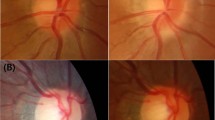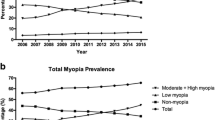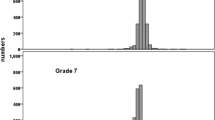Abstract
Purpose
To study the association of myopia progression with the morphological changes of optic disc and β-peripapillary atrophy (β-PPA) in 8–11 years old primary school students.
Methods
This study was a prospective, school-based investigation. This study included 610 children (1008 eyes) who were continuously observed and had data available from 2016 to 2017 in the Sanhe Cohort Study of the Risk Factors for Myopia (SCSRFM). The children underwent a comprehensive eye examination including measurement of visual acuity, autorefractometry, and posterior segment of the eye. β-PPA regions and optic disc ovality index were identified and measured on the fundus photographs.
Results
The prevalence of myopia was 72.62% (732/1008) in 2016. In myopic children, the prevalence of the vertical β-PPA, the horizontal β-PPA, and the oval optic disc were 75.68% (554/732), 75.96% (556/732) and, 11.61% (85/732) respectively. From 2016 to 2017, with the progression of vertical β-PPA, horizontal β-PPA, area of β-PPA, and optic disc ovality index, the myopic diopter and the axial length (AL) were increased. The progression of horizontal β-PPA was significantly correlated with the progression of myopic diopter and AL (all p < 0.05). The analysis on the distribution of progression rate of parameters in different groups found that the progression rate of horizontal β-PPA, area of β-PPA, and optic disc ovality index increased with the increase of the progression of diopter and AL. The progression of horizontal β-PPA, area of β-PPA, optic disc ovality index, and diopter in girls were greater than that in boys, and the progression of optic disc ovality index and diopter had a statistical significance (all p < 0.05).
Conclusions
The 1-year follow-up study of the third-grade primary school students showed that with the progression of myopia and the growth of AL, β-PPA and optic disc ovality index also changed. There was a positive correlation between the change of β-PPA and optic disc ovality index and the progression of myopia diopter and AL.


Similar content being viewed by others
References
Cai XB, Shen SR, Chen DF, Zhang Q, Jin ZB (2019) An overview of myopia genetics. Exp Eye Res 188:107778. https://doi.org/10.1016/j.exer.2019.107778
Jin ZB, Wu J, Huang XF, Feng CY, Cai XB, Mao JY, Xiang L, Wu KC, Xiao X, Kloss BA, Li Z, Liu Z, Huang S, Shen M, Cheng FF, Cheng XW, Zheng ZL, Chen X, Zhuang W, Zhang Q, Young TL, Xie T, Lu F, Qu J (2017) Trio-based exome sequencing arrests de novo mutations in early-onset high myopia. Proc Natl Acad Sci U S A 114:4219–4224. https://doi.org/10.1073/pnas.1615970114
Holden BA, Fricke TR, Wilson DA, Jong M, Naidoo KS, Sankaridurg P, Wong TY, Naduvilath TJ, Resnikoff S (2016) Global prevalence of myopia and high myopia and temporal trends from 2000 through 2050. Ophthalmology 123:1036–1042. https://doi.org/10.1016/j.ophtha.2016.01.006
Cai XB, Zheng YH, Chen DF, Zhou FY, Xia LQ, Wen XR, Yuan YM, Han F, Piao SY, Zhuang W, Lu F, Qu J, Yu AY, Jin ZB (2019) Expanding the phenotypic and genotypic landscape of nonsyndromic high myopia: a cross-sectional study in 731 Chinese patients. Invest Ophthalmol Vis Sci 60:4052–4062. https://doi.org/10.1167/iovs.19-27921
Jonas JB, Jonas SB, Jonas RA, Holbach L, Panda-Jonas S (2011) Histology of the parapapillary region in high myopia. Am J Ophthalmol 152:1021–1029. https://doi.org/10.1016/j.ajo.2011.05.006
Liu W, Gong L, Li Y, Zhu X, Stewart JM, Wang C (2017) Peripapillary atrophy in high myopia. Curr Eye Res 42:1308–1312. https://doi.org/10.1080/02713683.2017.1307992
Tong L, Saw SM, Chua WH, Luu C, Cheng B, Yeo I, Wong E, Tan D, Koh A (2004) Optic disk and retinal characteristics in myopic children. Am J Ophthalmol 138:160–162. https://doi.org/10.1016/j.ajo.2004.02.026
Samarawickrama C, Mitchell P, Tong L, Gazzard G, Lim L, Wong TY, Saw SM (2011) Myopia-related optic disc and retinal changes in adolescent children from Singapore. Ophthalmology 118:2050–2057. https://doi.org/10.1016/j.ophtha.2011.02.040
Samarawickrama C, Pai A, Tariq Y, Healey PR, Wong TY, Mitchell P (2012) Characteristics and appearance of the normal optic nerve head in 6-year-old children. Br J Ophthalmol 96:68–72. https://doi.org/10.1136/bjo.2010.197426
Kim TW, Kim M, Weinreb RN, Woo SJ, Park KH, Hwang JM (2012) Optic disc change with incipient myopia of childhood. Ophthalmology 119:21–26. https://doi.org/10.1016/j.ophtha.2011.07.051
Hwang YH, Kim YY (2012) Myopic optic disc changes in adolescents. Ophthalmology 119:885–886. https://doi.org/10.1016/j.ophtha.2011.12.004
Sung MS, Kang YS, Heo H, Park SW (2016) Characteristics of optic disc rotation in myopic eyes. Ophthalmology 123:400–407. https://doi.org/10.1016/j.ophtha.2015.10.018
Guo Y, Liu LJ, Xu L, Lv YY, Tang P, Feng Y, Zhou JQ, Meng M, Jonas JB (2014) Parapapillary beta zone in primary school children in Beijing: associations with outdoor activity. Invest Ophthalmol Vis Sci 55:918–925. https://doi.org/10.1167/iovs.13-13502
Guo Y, Liu LJ, Xu L, Lv YY, Tang P, Feng Y, Zhou JQ, Meng M, Jonas JB (2015) Optic disc ovality in primary school children in Beijing. Invest Ophthalmol Vis Sci 56:4547–4553. https://doi.org/10.1167/iovs.15-16590
Mak CY, Yam JC, Chen LJ, Lee SM, Young AL (2018) Epidemiology of myopia and prevention of myopia progression in children in East Asia: a review. Hong Kong Med J 24:602–609. https://doi.org/10.12809/hkmj187513
Xiang ZY, Zou HD (2020) Recent epidemiology study data of myopia. J Ophthalmol 2020:4395278. https://doi.org/10.1155/2020/4395278
Grzybowski A, Kanclerz P, Tsubota K, Lanca C, Saw SM (2020) A review on the epidemiology of myopia in school children worldwide. BMC Ophthalmol 20:27. https://doi.org/10.1186/s12886-019-1220-0
Li Z, Guo X, Xiao O, Lee PY, Liu R, Wang D, Sankaridurg P, He M (2018) Optic disc features in highly myopic eyes: the ZOC-BHVI High Myopia Cohort Study. Optom Vis Sci 95:318–322. https://doi.org/10.1097/OPX.0000000000001200
Ohno-Matsui K, Lai TY, Lai CC, Cheung CM (2016) Updates of pathologic myopia. Prog Retin Eye Res 52:156–187. https://doi.org/10.1016/j.preteyeres.2015.12.001
Chen Q, He J, Yin Y, Zhou H, Jiang H, Zhu J, Ohno-Matsui K, Zou H, Fan Y, Xu X (2019) Impact of the morphologic characteristics of optic disc on choroidal thickness in young myopic patients. Invest Ophthalmol Vis Sci 60:2958–2967. https://doi.org/10.1167/iovs.18-26393
Sung MS, Heo H, Park SW (2018) Microstructure of parapapillary atrophy is associated with parapapillary microvasculature in myopic eyes. Am J Ophthalmol 192:157–168. https://doi.org/10.1016/j.ajo.2018.05.022
Czepita M, Czepita D, Safranow K (2019) Role of gender in the prevalence of myopia among Polish schoolchildren. J Ophthalmol 2019:9748576. https://doi.org/10.1155/2019/9748576
Rudnicka AR, Kapetanakis VV, Wathern AK, Logan NS, Gilmartin B, Whincup PH, Cook DG, Owen CG (2016) Global variations and time trends in the prevalence of childhood myopia, a systematic review and quantitative meta-analysis: implications for aetiology and early prevention. Br J Ophthalmol 100:882–890. https://doi.org/10.1136/bjophthalmol-2015-307724
Gao TY, Zhang P, Li L, Lin Z, Jhanji V, Peng Y, Li ZW, Sun LP, Han W, Wang NL, Liang YB (2014) Rationale, design, and demographic characteristics of the Handan Offspring Myopia Study. Ophthalmic Epidemiol 21:124–132. https://doi.org/10.3109/09286586.2014.887734
Queiros A, Gonzalez-Meijome J, Jorge J (2008) Influence of fogging lenses and cycloplegia on open-field automatic refraction. Ophthalmic Physiol Opt 28:387–392. https://doi.org/10.1111/j.1475-1313.2008.00579.x
Suryakumar R, Bobier WR (2003) The manifestation of noncycloplegic refractive state in pre-school children is dependent on autorefractor design. Optom Vis Sci 80:578–586. https://doi.org/10.1097/00006324-200308000-00012
Funding
The Beijing Hospitals Authority provided financial support in the form of Beijing Hospitals Authority Clinical medicine Development of special funding support (XMLX202133) funding; the work committee for women and children of China State department provided financial support in the form of Fund of work committee for women and children of China State department (2014108) funding; and the Beijing Institute of Ophthalmology provided financial support in the form of Beijing Institute of Ophthalmology Key Research Program Funding Projects (2019009) funding.
The sponsors had no role in the design or conduct of this research.
Author information
Authors and Affiliations
Contributions
Conception and design (XHW, JSZ, JL, JDW); acquisition of data (JSZ, JL, JDW, YX, SMH, XLS, SYC, ZYL); analysis and interpretation of data (JSZ, KC); drafting the article or revising it (SJZ, MY); final approval of the version (ZBJ, NLW, XHW).
Corresponding author
Ethics declarations
Ethical approval
All procedures performed in studies involving human participants were in accordance with the ethical standards of the Institutional Review Board of Beijing Tongren Hospital (QN20150228), Capital Medical University and with the 1964 Helsinki declaration and its later amendments or comparable ethical standards.
Informed consent
Informed consent was obtained from all individual participants included in the study.
Conflict of interest
The authors declare no competing interests.
Additional information
Publisher's note
Springer Nature remains neutral with regard to jurisdictional claims in published maps and institutional affiliations.
Rights and permissions
About this article
Cite this article
Zhang, JS., Li, J., Wang, JD. et al. The association of myopia progression with the morphological changes of optic disc and β-peripapillary atrophy in primary school students. Graefes Arch Clin Exp Ophthalmol 260, 677–687 (2022). https://doi.org/10.1007/s00417-021-05331-9
Received:
Revised:
Accepted:
Published:
Issue Date:
DOI: https://doi.org/10.1007/s00417-021-05331-9




